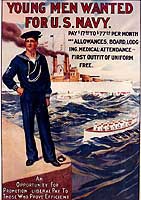Student Introduction
Background Essay
At the turn of the nineteenth century, the United States was a nation rapidly growing in all aspects. Not only was the population in cities increasing, but the U.S. acquired new island territories in the Pacific Ocean and the Caribbean Sea. The job of maintaining open sea lanes fell to the U.S. Navy. For example, since the United States stretched from the Atlantic and Pacific, the U.S. wanted a passageway between North and South America to cut the travel time between the east and west coast. The Navy helped secure the land where the Panama Canal would be built and finally opened in 1914.
In 1907, President Theodore Roosevelt sent 16 battleships and other vessels on a 14-month, 42,227 mile cruise around the globe. "The Great White Fleet," nicknamed because each ship was painted white, had a mission to advance American diplomacy and exhibit the strength of the United States as a new world power. At this point in time, the U.S. Navy was also growing with an underwater submarine added in 1900 and air power first used on ships in 1910.
In order to maintain such a strong and well-trained force, the Navy needed to attract and train a lot of men to work on board their ships. The poster on the right is an example of the Navy's attempt to recruit more sailors.
Poster art was a major means of advertising in the early twentieth century. It was an easy way to reach a large number of people, since there was neither commercial radio nor television, and not everyone purchased newspapers and magazines. Posters were placed on walls along busy streets in small towns and large cities and reached millions of people. Posters were mass produced, inexpensive, and easily distributed nationwide. Posters provided the easiest way for branches of the military, including the Navy, to advertise to a national audience.
Life wasn't always as good as the Navy recruiting posters advertised, as you will see by comparing the poster (circa 1910) with a poem (1910) written about the life of a naval recruit. (This poem was printed on a postcard that was sent by Henry Norman, a Navy band member to his mother, Mrs. R. Norman who lived in Connecticut.)
Think of how the poster and poem function as historical evidence for understanding American and naval history. But, be careful. Remember that recruiting posters are supposed to attract people, and that Sea Going Tony might have exaggerated his story.




